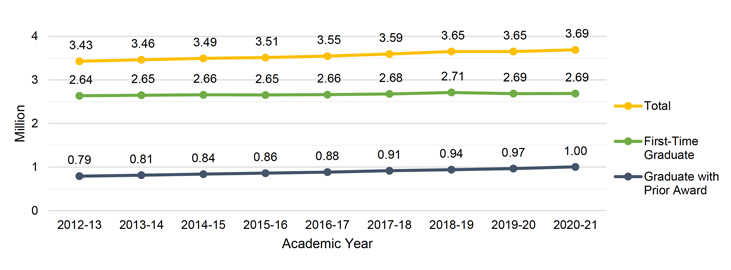- BLOG HOME
- »
- Undergraduate Degree Earners Report
- »
- Undergraduate Credential Earners Increased By 1.1% to 3.7 Million Graduates

Undergraduate Credential Earners Increased By 1.1% to 3.7 Million Graduates
In the 2020-21 academic year, the total number of undergraduate credential earners increased by 1.1% or 39,000 to 3.7 million graduates, based on the Undergraduate Degree Earners Report, Academic Year 2020-21. After a brief standstill in the previous year, graduate numbers began to rise again.
After the initial standstill in the 2019-20 academic year, the overall number of undergraduate-level credential earners started to increase, continuing the pre-pandemic upward trend. This growth was fueled by students earning stacked credentials, particularly bachelor’s degree earners — including 22,000 additional baccalaureates with a prior associate degree.
“The growth in overall undergraduate credential completers this year is two-sided news,” said Mikyung Ryu, director of research publications for the National Student Clearinghouse Research Center. “The overall growth was led by stacked credential earners, but first-time graduates as a whole had no growth. This implies a growing dichotomy of the haves and have-nots in postsecondary attainment.“
Other report highlights include:
- Declines in first-time graduates have stabilized, following an unusually large drop the year prior (-0.9% or over 25,000 fewer students). Certificate earners continued a downward trend (-2.6%, -11,800), while baccalaureates continued to increase (+0.7%, +10,600). Associate degree earners showed signs of rebound (+0.3%, +2,500) following a major drop the year prior (-3.7%, -28,000).
- Traditional college-age students under 25 continued to decline in first-time associate degree and certificate completion, the age group comprising the majority of sub-baccalaureate level completers.
- The number of older first-time graduates (25 and older) increased (+1.4%, +10,350), driven largely by the growth of graduates in their 30s (+4.3%, +10,700).
The Undergraduate Degree Earners report series, published annually, provides demographic and educational profiles for all students graduating with an undergraduate credential each year. Undergraduate credentials may include associate and bachelor’s degrees and certificates.
In the current report, the Research Center profiles graduates in the 2020-21 academic year, with a focus on first-time versus non-first-time graduates, and changes in demographics and education credentials received over the last nine academic years, since 2012-13. The Appendix provides state-level and regional trends, in addition to the national graduate profiles by age and type of credential received.
Overall Undergraduate Credential Earners

“The overall growth was led by stacked credential earners, but first-time graduates as a whole had no growth. This implies a growing dichotomy of the haves and have-nots in postsecondary attainment.”
Mikyung Ryu
Director of research publications , National Student Clearinghouse Research Center
Additional Resources:



